
Fish And Fur . . . We Make Our Living
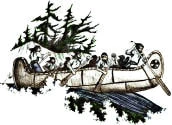

|
Vital is a resident of Ile-a-la-Crosse who holds many jobs and positions. He is active in local government and is the Chairman of the local school board. 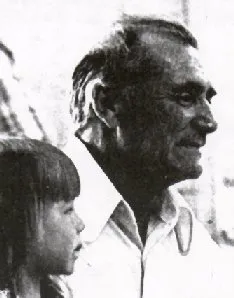
"As far as I can recall, I was fairly young when my dad died. I could remember him telling me stories about him starting off early in break-up in the first part of May to go to Churchill to pick up freight for the Hudson's Bay Company. It used to take them about six months to make a round trip, to go up there and back in late fall around October, when waterways froze". "My dad used to tell me that trip was fairly easy going down the current. They were all loaded coming up the current. At a lot of rapids that are fairly swift and shallow, they had to get tow ropes on each side of the river and pull the barges, empty, up the rapids. They had to haul all their supplies across the portage on their backs to above the top of the rapids. There were no outboard motors, it was all by paddle. They had paddles on both sides of these boats. I don't know how many men, but I figured around five on each side and one fellow in the stern at the big steering paddle. It took them four or five months to come up from Churchill to Ile-a-la Crosse by these boats". "He also used to freight from Big River by barge (scow). They used to go by canoe to Big River, through the Beaver River, there, down the Cowan River, then up the Cowan Lake into Big River. Big River used to be a supply depot at that time". 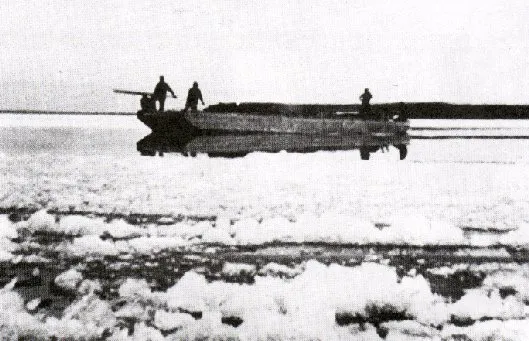
(Photo Courtesy: Ile-a-la Crosse Mission). "They used to get lumber and build barges. These barges were filled up with supplies, and bring those supplies here. Once they got here, they used to tear these barges apart. We used the lumber to build houses". "My dad's name was Felix Morin. My grandfather was Catholique Morin. My dad died at 66 around 1954. I was only 33 years old then". "I started going on my own after I had completed grade nine. I went and fished for Frank Nordstrom at Little Peter Pond Lake. What we did was we had a camp on the fish lines. You punch holes in the ice, you had one-hundred yard nets and a jigger. A jigger is a machine that is made with a board (plank approx. 2 inches thick, 12 inches wide, and 8-10 feet long) with a pick on it. You pull it (the running line) and make it go one or two feet at every pull. At the end of a hundred yards you punch another hole, push your jigger up ahead, grab the line, and tie that line to the end of the net. Then you get one man pulling that line in. That's the way you set nets (under the ice)". "When you come to lifting (the net), you punch a hole at one end and tie a line (called a running line) about 150 yards long. Two men pull - one on the lead line, and one on the float line. On the ice, you pull the fish out. As you take them out, keep pulling the net. After you clean all of fish out of the net, you get one man to run to the other hole and pull the net back in again (under the ice and into the water)". "We used to use wool mitts, and we had these fish hooks to get around the nets (netting) so that you could ungill the fish. It made it a lot easier, because with wool mitts it's kind of hard to get into this fine twine. It was cold work, but once you get used to the weather, it doesn't bother you. You could be out on the lake at 30 below and the wind blowing 15 miles per hour, and it won't bother you. You're dressed for it". "When I was fifteen, I remember then, the freighting was done with teams of horses in the winter time. They brought the freight into the stores and took the furs and fish back to market in the south". "There used to be strings of around 30 to 40 teams of horses in one line at a time. Three or four teams were in front to push the (snow) plow over all these lakes. The route was through the Cowan Lake up to Dore Lake, then to the Beaver River up around Beauval. Then, they went down the Beaver River into Ile-a-la Crosse Lake, then into Buffalo Narrows". "The main point was at Buffalo (Narrows) and used to spread out from there, go up to the Peter Pond Lake, Little Peter Pond, Churchill Lake, and all these other places to pick up fish and get supplies in. There were quite a few accidents. Teams used to go through the ice. The Beaver River was one of the bad areas, because the river always has bad ice in places". "From Big River up Cowan Lake, Dore Lake, Beauval, there were stopping places. From there, they used to come into the mouth of the Beaver River around Ile-a-la Crosse here. That stopping place used to belong to Dick Kirby. They had great stables made out of logs - they used to hold twenty teams or more. Also they had bunkhouses for the freighters to stay in. They had a big cook shack where all the people used to eat. The horses were all looked after by the freighters themselves. They carried most of their feed - hauled oats and hay". "The next stopping place was on Deep River, and was run by Halvor Ausland. From there, they went right into Buffalo (Buffalo Narrows). There were three different people who had stopping places - (in Buffalo Narrows) Tom Pedersen, Ryder Petersen and my uncle, Louis Morin". "There used to be a wagon road from Fort Black all the way to Meadow Lake. That road was cut open. There was a government project in those days. I worked on that road myself, that was in the forties. The road was all hand made - corduroying the soft spots, the sandy spots, and then pulling some soil on top of that. There were a lot of mud holes. At that time, we worked for 50 cents a day, his was in 1940-41. The work was shovel and axe. We used to fill the wagons with sand or clay, or, whatever we could get close by. Also, chop poles and the teams of horses would haul the poles to the soft places to corduroy it. Then we'd put some sand or clay on top of the corduroy so the trucks wouldn't bunch up the poles. I remember we were up around mile 41, around the foot of the Grand Rapids on the Beaver River." "I got discharged from the army in October, 1945. I spent the late fall and early winter commercial fishing at Patuanak. Me and my brother Harry, were commercial fishing. We did some trapping in the spring, muskrat and beaver." "Finally, on July 1st, 1946, I got married. That day a very big celebration was taking place. The mission was celebrating it's 100th anniversary. We must of had five to six thousand people here in Ile-a-la Crosse from all the surrounding communities coming to the celebrations. We had a Cardinal come from way down Quebec somewhere. He came to help the celebration here. The Mass was done at ten o'clock in the morning, and that's where I was married, right outside the Church. There were six couples married that same day. One was M. Bouvier, another was George Maurice who lives at Jans Bay now. Francis Opikokew from Canoe Lake, and two couples from LaLoche". 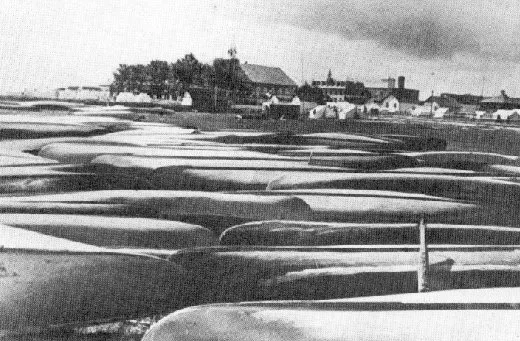
(Photo Courtesy: Ile-a-la-Crosse Mission).
Roy Simpson
Roy is the manager of the Hudson's Bay Company Store in Ile-a-la-Crosse,
and has been here at that job since January 19th, 1959. "We did employ men during the winter to do what they called in those days - tripping. "Tripping" was that a man had a dog team and toboggan, and he would go right after freeze up in the fall. He took some provisions from the store - flour, lard, sugar, tobacco, etc. and he would go out on the traplines to different camps where the natives were camped doing their trapping. He would barter with the natives for the fur they would have and then bring the furs back to the store. He might make three or four of these trips during the winter". "When I first came, there were quite a number of trappers in the Ile-a-la-Crosse area. Over the years, I have noticed that our younger people are not taking up the fur trade - the trapping trade - that I think they possibly should. I still maintain there is a good living to be had in trapping. I don't mean that you take sixty or seventy young people and say " you go trapping!" There is such a thing as to over trap. So, maybe it's only good for ten or fifteen people. I still think we aren't doing what we should to maintain the tradition". "We had our trappers. We had a book which had the trappers name in, and the furs that we bought from him during the winter. We added it all up during the spring. The man who was a very good trapper, he brought in four to six thousand dollars worth of furs in the winter. On the strength of what he produced, we were prepared, in the fall to give credit in goods knowing that he would come back and give us all that he had and straighten up his bills". "When the community started building in the downtown area, the company moved our old store and warehouse to beside the RCMP's present location from the site in Snob Hill where my house is situated. I had the privilege of staying in that old store for twelve years. It was truthfully, too small a store to handle the trade and public we had coming in. We put up with it until 1972. In 1972, we got into our new building. I think the customers like it too. There's more room to move around". 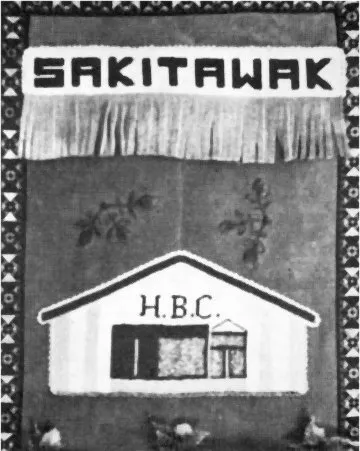
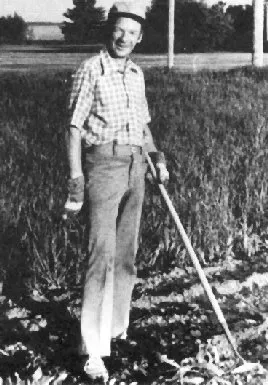
Roy Simpson
"Well I do remember the little school, the little grey building down by the mission. I believe it had four rooms with a box stove in the center, and a cordwood pile outside. The teacher would have to get up every once in a while to throw another piece of wood into the stove. This was frozen, that was frozen. People had to wear mukluks and what-have-you-on your feet. That was part of the deal, that was the educational system. I thought that if nothing else, we will likely get a hardy breed coming out of there". "Fortunately, we survived that system and by 1962, it was decided to embark on a good school for Ile-a-la-Crosse. There was quite a difference. They had oil furnaces and they had running water. The children just ate it up. They thought that this was great." "In two years, they added more classrooms. Then they added the "L" wing which still exists today. An auditorium was added on several years ago. And now, we have a new building. In terms of education, Ile-a-la-Crosse has certainly progressed in no uncertain terms. If our community is to ever succeed, stand on its own feet, then that is what we need - education!" 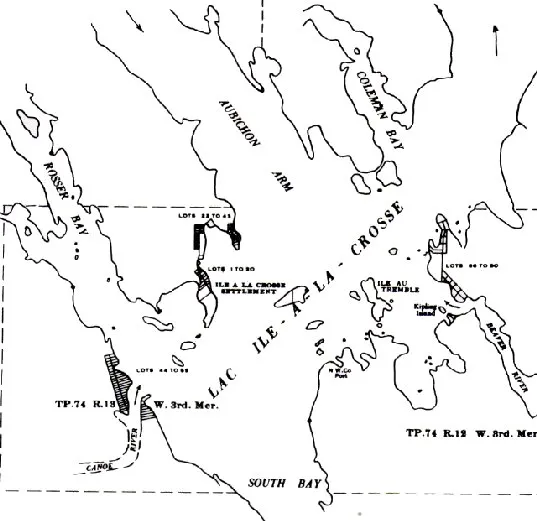
Public Archives of Canada. |
| Ausland Lake |
Northern Saskatchewan
| Deep River Fur Farm |
| Deep River Trapping Page |
| Deep River Fishing Page |
| My Norwegian Roots |
| Early Mink of People Canada |
E. Rendle Bowness
| The Manager's Tale |
Hugh McKay Ross
| Sakitawak Bi-Centennial |
200 Year History.
| Lost Land of the Caribou |
Ed Theriau
| A History of Buffalo Narrows |
| Hugh (Lefty) McLeod |
Bush Pilot
| George Greening |
Bush Pilot
| Timber Trails |
A History of Big River
| Joe Anstett, Trapper |
| Bill Windrum, Bush Pilot |
| Face the North Wind |
By Art Karas
| North to Cree Lake |
By Art Karas
| Look at the Past |
A History Dore Lake
| George Abbott |
A Family History
| These Are The Prairies |
| William A. A. Jay, Trapper |
| John Hedlund, Trapper |
| Deep River Photo Gallery |
| Cyril Mahoney, Trapper |
| Saskatchewan |
A Pictorial History
| Who's Who in furs |
1952 to 1956
| A Century in the Making |
A Big River History
| Wings Beyond Road's End |
| The Northern Trapper, 1923 |
| My Various Links Page |
| Ron Clancy, Author |
| Roman Catholic Church |
A History from 1849
| Frontier Characters - Ron Clancy |
| Northern Trader - Ron Clancy |
| Various Deep River Videos |
| How the Indians Used the Birch |
| The Death of Albert Johnson |
| A Mink and Fish Story |
Buffalo Narrows
| Gold and Other Stories |
Berry Richards

